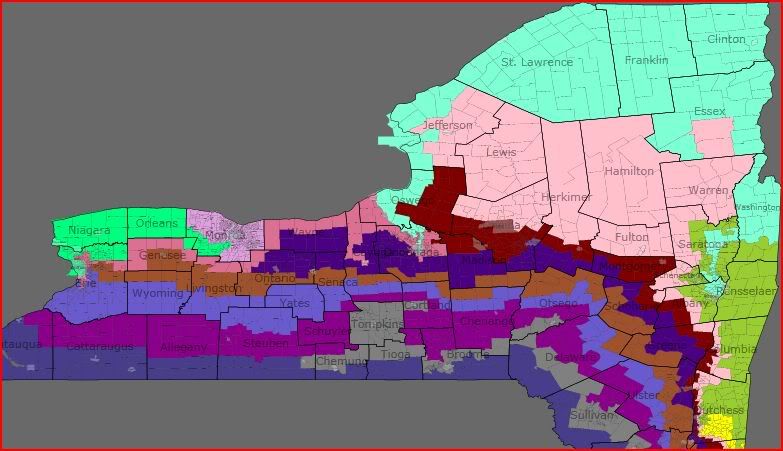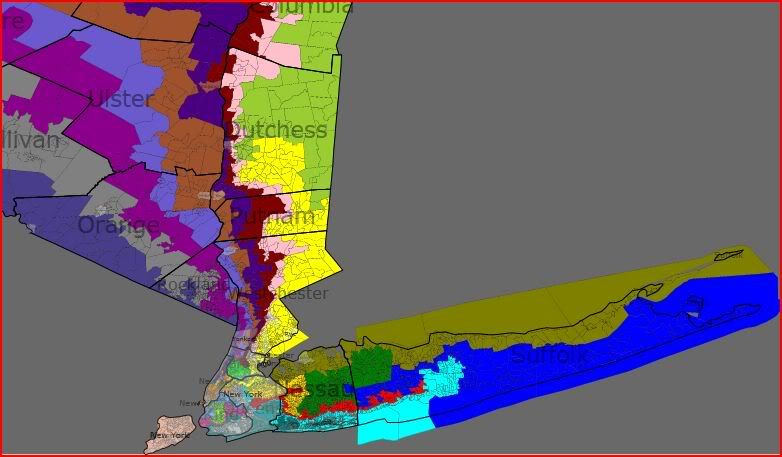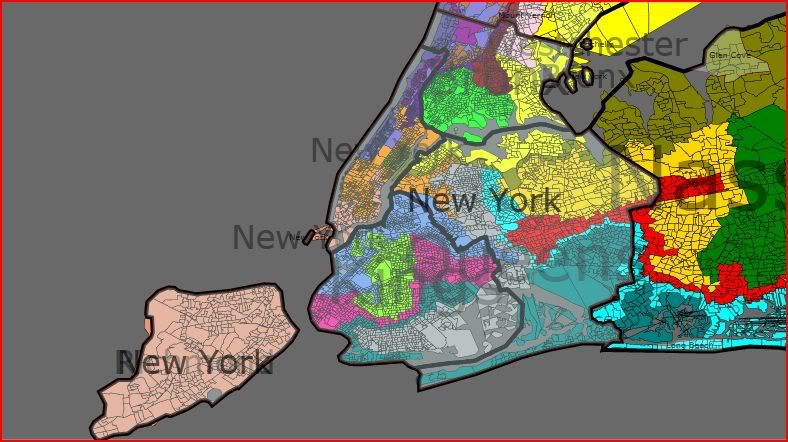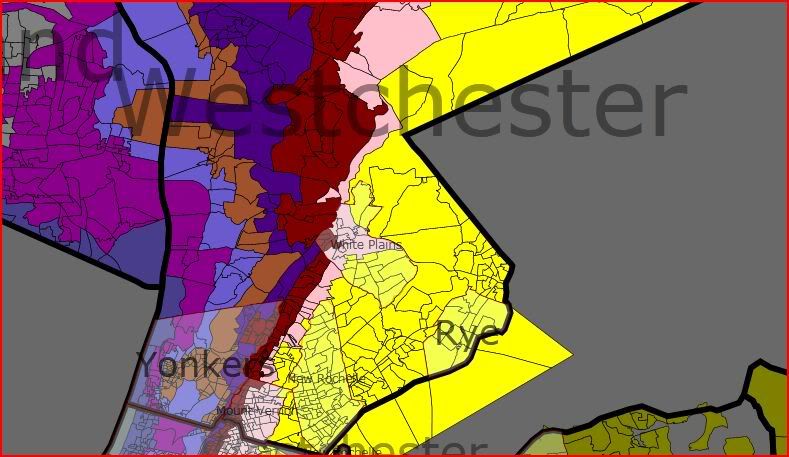The idea behind this plan is to create 28 districts that Democrats can expect to win, while pushing back against conservative charges of gerrymandering by creating districts that are relatively compact. In my mind, a district was likely to elect a Democrat if it gave Barack Obama 54% of the vote or more – i.e. at least one point more than the national average. There is a risk that in a heavily Republican year a number of Democrats could get splattered, but once things shifted back they should be able to pick most of these seats back up.
In addition, I wanted to create districts that split as few counties as possible. Obviously, you can’t avoid county-splitting without violating one-person-one-vote, but I’ve managed to keep this to a minimum. In the NYC area, all bets are off, though districts are more compact than they’ve probably been since the 1980s.
Because many of these districts are only marginally Democratic, I also tried to keep as much of an incumbent’s “home turf” as possible. You’ll recognize most of these districts, but the changes are substantial.
In sum, I split up Lee’s district between Massa, Slaughter, Arcuri and Higgins. Peter King loses most of his present district, and gains Southwestern Nassau County. In a 55% Obama district with a substantial African American population, I think he’ll find it quite difficult to survive. Suffolk is split up three ways. Other than that, I think you’ll recognize the map pretty easily.
As a side note, this non-New Yorker (who avoids the City as much as possible) was pretty shocked to learn how much of South Brooklyn votes like Texas (I do know that the demographics are NOTHING like Texas, but I didn’t realize just how heavily Republican they voted). The 91% McCain precincts made the map-drawing there much more difficult than I expected.
(BTW, no idea why the images screwed up like they did. If anyone has a clue let me know and I’ll re-try).










District 1: Tim Bishop
Current District: Obama 52%, McCain 48%
Proposed District: Obama 54%, McCain 46%
Population: 700,592
Demographics: 78% white, 7% bl, 2% asn, 12% hisp., 2% other.
The idea here is to split the fairly Democratic Hamptons, which enables Bishop to pick up some more heavily Democratic voters in Islip and Babylon. Bishop also gets some Democratic precincts around Plainview.
District 2: Steve Israel
Current District: Obama 56%, McCain 43%
Proposed District: Obama 54%, McCain 46%
Population: 701,787
Demographics: 78% white, 7% bl, 3% asn, 10% hisp., 1% other.
This is most of northern Suffolk County. Israel picks up some Republican towns on the North Shore, but gains part of the Hamptons to offset a bit.
District 3: RIP, Peter King
Current District: Obama 47%, McCain 52%
Proposed District: Obama 55%, McCain 44%
Population: 701,964
Demographics: 72% white, 13% bl, 3% asn, 10% hisp., 2% other.
King loses almost all of his district, which is now roughly the bottom third of Nassau County, and gains the most heavily Democratic portions of McCarthy’s old district. Overall, this is a huge drop in Republican performance, and a big gain in Democratic performance. Moreover, about 2/3 of his constituents are new to him, and a lot of them aren’t particularly friendly. He can’t move to the 4th or 5th because of what we’re doing there. To the extent Republicans complain, three horizontal districts is exactly how Nassau County was configured in the 1960s, when it was advantageous to evenly distribute the Republican vote.
District 4: Carolyn McCarthy.
Current District: Obama 58%, McCain 41%
Proposed District: Obama 58%, McCain 41%
Population: 703,628
Demographics: 82% wh, 12% bl, 1% asn, 3% hisp, 1% other
McCarthy has quite a few new constituents, but most of them are Democrats. To the east, she picks up Jericho and surrounding counties, and then gets a bunch of racially mixed counties in Queens out of the Old Ninth. The population base is still Nassau, so I don’t see much risk of a primary challenge here.
District 5: Gary Ackerman
Current District: Obama 63%, McCain 36%
Proposed District: Obama 55%, McCain 44%
Population: 702, 300
Demographics: 65% wh, 3% bl, 19% asn, 11% hisp, 2% other
Ackerman might not like the district, which is much more Republican and which now stretches across Northern Long Island into Suffolk County. On the other hand, this is a lot of territory that he had in the 1992 iteration of the district, and he has to pick up new areas due to population loss anyway. He could be vulnerable to a primary challenge, but ultimately low voter participation among recent Hispanic and Asian immigrants probably maintains a pretty white primary electorate here.
District 6: Gregory Meeks
Current District: Obama 89% McCain 11%
Proposed District: 81% McCain 19%
Population: 699,514
Demographics: 26% wh, 50% bl, 5% asn, 13% hisp, 6% other
It is becoming very, very difficult to maintain three black majority districts in New York City due to population loss and losing district. We’ll see this in Pennsylvania, Illinois and Michigan this time around as well, where black majority districts created in the 1970s and 1980s are just stretched too thin to continue to exist. Anyway, Meeks’ district grows west into Brooklyn and maintains its black majority – barely – by picking up some heavily black precincts near Sea Gate and Coney Island.
District 7: Joe Crowley
Current District: 79% Obama, 20% McCain
Proposed District: 83% Obama, 16% McCain
Population: 701,950
Demographics: 27% wh, 27% bl, 5% asn, 37% hisp, 4% oth
Crowley’s district loses a lot of Queens, and becomes much more of a Bronx-based district, connected by the Bronx-Whitestone bridge. It’s actually probably a better district for Crowley than his present one, due to low turnout among new minorities. I doubt he’ll miss Jackson Heights.
District 8: Jerrold Nadler
Current District: 74% Obama, 26% McCain
Proposed District: 82% Obama, 20% McCain
Population: 702,525
Demographics: 56% wh, 5% bl, 17% asn, 19% hisp
Because I push Velazquez’s district back into Queens, Nadler picks up Hispanic precincts in Southern Manhattan, as well as some old Maloney districts. Other than that, this should look pretty familiar; it now crosses over the Brooklyn Bridge, and again, I don’t think he’ll miss Bensonhurst.
District 9: Anthony Weiner
Current District: 55% Obama, 45% McCain
Proposed District: 63% Obama, 37% McCain
Population: 700, 751
Demographics: 57% wh, 10% bl, 14% asn, 16% hisp, 4% other
Weiner loses some of Central Queens to the Fourth, and loses his connection to Brooklyn due to the new Sixth extending all the way across Jamaica Bay. So I did one of the few really grotesque things with this map. I put a “tunnel” through East New York to get to a lot of Weiner’s old Brooklyn constituents, and to help break up “Little Texas” in South Brooklyn. If I just did water contiguity, I could probably “pretty” this up quite a bit.
District 10: Ed Towns
Current District: 91% Obama, 9% McCain
Proposed District: 80% Obama, 20% McCain
Population: 704,800
Demographics: 27% wh, 50% bl, 5% asn, 15% hisp, 3% oth
This district maintains its black majority (barely) and is much more compact than the present district. It is still based around East New York. The problem is that with stagnant population growth and the need of every district in the state to take on a fair number of new constituents due to the eliminated district, there just aren’t a whole lot of African American voters to split between three black-majority districts. So I took some additional voters from Little Texas and added them on. They won’t be voting in a Democratic primary anytime soon anyway.
District 11: Yvette Clarke
Current District: 91% Obama, 9% McCain
Proposed District: 85% Obama, 15%
Population: 693,425
Demographics: 27% wh, 50% bl, 5% asn, 15% hisp, 3% other
Clarke has to pick up a substantial number of new constituents as well, from her Bed-Stuy district, so I use her to break up South Brooklyn. This is one of the bigger deviations from the equal population standard, but it’s hard to bring her numbers up while maintaining the black majority.
District 12: Nydia Velazquez
Current District: 86% Obama, 13% McCain
Proposed District: 82% Obama, 17% McCain
Population: 700,933
Demographics: 19% wh, 12% bl, 14% asn, 52% hisp, 3% other
This is more like Velazquez’s 1990s district, which took in the Hispanic vote in Northern Queens, rather than NYC. There’s an ugly tunnel across Brooklyn to connect to Velazquez’s home in Carroll Gardens, but this is still an improvement in terms of compactness from the present one.
District 13: Michael McMahon
Current District: 49% Obama, 51% McCain
Proposed District: 54% Obama, 46% McCain
Population: 695, 331
Demographics: 65% wh, 7% bl, 10% asn, 15% hisp, 2% other
I was bound and determined not to split Staten Island and not to use the Staten Island ferry to connect the district to the City. It just didn’t work – I could get up to 53% Obama but not 54%. I suppose if I knew the City better I could do it, but I didn’t feel like testing out every precinct in Brooklyn. Besides, for most of the district’s existence it was joined with Manhattan via the ferry anyways, not into Brooklyn, so I can live with this.
District 14: Carolyn Maloney
Current District: 78% Obama, 21% McCain
Proposed District: 80% Obama, 19% McCain
Population: 697, 918
Demographics: 54% wh, 12% bl, 8% asian, 22% hisp, 4% other
Maloney loses a good chunk of the Lower East Side, but picks up Clinton Hill, Williamsburg, and Greenpoint. Connection to the island is still through the Queens Midtown Tunnel.
District 15: Charlie Rangel
Current District: 93% Obama, 6% McCain
Proposed District: 93% Obama, 6% McCain
Population: 706, 188
Demographics: 20% wh, 29% bl, 3% asn, 46% hisp, 2% other.
Not a whole lot of changes for Rangel, who goes a little further into the Upper East Side and loses Queens. Rangel could be vulnerable to a primary challenge from the burgeoning Hispanic community, which isn’t necessarily a bad thing.
District 16: Jose Serrano
Current District: 95% Obama, 5% McCain
Proposed District: 93% Obama, 7% McCain
Population: 703,044
Demographics: 6% wh, 29% bl, 2% asn, 61% hisp, 2% other
Not many changes here to this Southwest Bronx district. This remains among the top 5 most heavily Democratic districts in the country.
District 17: Eliot Engel
Current District: 72% Obama, 28% McCain
Proposed District: 55% Obama, 45% McCain
Population: 698, 694
Demographics: 73% wh, 10% bl, 4% asn, 12% hisp, 2% other
Oh, Engel’s not going to like this. He loses a chunk of the Bronx and gains all of Sullivan and half of Orange County. He could presumably lose a primary, but while Engel is a solid liberal, he’s not really a rock star of the party. If you aren’t obsessed with keeping counties together, you could give Nita Lowey parts of Rockland in exchange for parts of Yonkers and shore Engel up. But at the end of the day, this is how you make upstate districts more Democratic.
District 18: Nita Lowey
Current District: 62% Obama, 38% McCain
Proposed District: 67% Obama, 33% McCain
Population: 707, 243
Demographics: 56% wh, 20% bl, 4% asn, 17% hisp, 3% other
Lowey gets more of Westchester and a more Democratic district. She’ll still like this a lot more than her 1992 district, which actually went down in the Bronx and Queens.
District 19: John Hall
Current District: 51% Obama, 48% McCain
Proposed District: 54% Obama, 46% McCain
Population: 700,714
Demographics: 79% wh, 7%bl, 3% asn, 10% hisp, 1% other
Hall is still the one to represent FDR’s old stomping grounds. He gives up a chunk of Orange and Rockland Counties and gets a lot of Westchester, while keeping his Dutchess and Putnam County bases. That’s a good trade for him; he’ll still be the one here.
District 20: Scott Murphy
Current District: 51% Obama, 48% McCain
Proposed District: 54% Obama, 45% McCain
Population: 704,604
Demographics: 91% wh, 4% bl, 1% asn, 2% hisp, 1% other
This district becomes much more compact. It loses its spike into Essex County and its extension into Delaware County, but it gains heavily Democratic parts of Rensselear and an Albany precinct for 1p1v purposes. Much better territory for Murphy.
District 21: Paul Tonko
Current District: 58% Obama, 40% McCain
Proposed District: 55% Obama, 43% McCain
Population: 697,033
Demographics: 89% wh, 5% bl, 1% asn, 3% hisp, 1% other
The heart of this district actually remains very much the same: Albany, Schoharie and Montgomery counties. Tonko loses the city of Schenectady to shore up the 23rd, and picks up lightly populated, but fairly Republican Cortland, Chenango, Otsego, Greene and Herkimer Counties. Tonko should have little trouble keeping this seat, even with the reduced Democratic percentages.
District 22: Maurice Hinchey
Current District: 59% Obama, 39% McCain
Proposed District: 56% Obama, 42% McCain
Population: 704,793
Demographics: 89% wh, 3% bl, 2% asn, 3% hisp, 2% other
Hinchey loses the Sullivan and parts of Rockland Counties. Because of population loss, he picks up entire versions of Delaware, Broome, Tioga, and Tompkins Counties, and then takes Chemung, Schuyler and Yates out of the 29th and 26th. The tendril over to Ithaca is actually less obvious because of this, and it’s a nicer looking district. He keeps all of his Ulster base.
District 23: Bill Owens
Current District: 52% Obama, 46% McCain
Proposed District: 54% Obama, 44% McCain
Population: 702, 958
Demographics: 91% wh, 3% bl, 1% asn, 2% hisp, 1% other
This district is fundamentally unchanged. Owens loses the more conservative portions of Oneida County and Madison County, while picking up the heavily Democratic Schenectady precincts. The three North Country are still kept together.
District 24: Mike Arcuri
Current District: 51% Obama, 48% McCain
Proposed District: 54% Obama, 45% McCain
Population: 696, 248
Demographics: 88% wh, 6% bl, 1% nat, 1% asn, 2% hisp, 1% other
Gone is the crescent-shaped old 24th. Instead, Arcuri keeps his Oneida County base, and picks up a chunk of Syracuse, with Madison in between. It’s a good tradeoff for the rural counties he gives up, though he may be more vulnerable to a primary challenge.
District 25: Dan Maffei
Current District: 56% Obama, 43% McCain
Proposed District: 54% Obama, 45% McCain
Population: 696,671
Demographics: 88% wh, 6% bl, 2% asn, 2% hisp, 1% other
Pretty simple concept going on here. Maffei keeps most of central Syracuse, and Wayne County, picks up some suburbs of the ‘Cuse, a couple of small rural districts, and a lot more of Rochester. Population loss in this area just requires everyone to get a lot of new constituents regardless, but his district is pretty safe.
District 26: Brian Higgins
Current District: 54% Obama, 44% McCain
Proposed District: 54% Obama, 44% McCain
Population: 694,363
Demographics: 83% wh, 10%bl, 1% nat, 1%asn, 4% hisp, 8% other
Higgins picks up Cattaraugus, Allegany, and part of Wyoming Counties, but makes up for it with more of central Buffalo. It’s a wash for him. As a side note, I’m genuinely interested what the 8% “other” is.
District 27: Louise Slaughter
Current District: 69% Obama, 30% McCain
Proposed District: 54% Obama, 44% McCain
Population: 693,836
Demographics: 85%wh, 8% bl, 2% asn, 4% hisp, 1% other
Okay, first a gripe. If Slaughter would move to the west side of Rochester, we could do a lot better here. Since she’s 80, I was half tempted to just do it anyway, but I guess I don’t get to make the contest rules. 🙂 Anyway, by expanding into Orleans County she gets a more compact-looking district. Her failure to hoard Democrats in Buffalo and Rochester is why this whole thing works. This could result in the election of a blue dog-type Democrat, but trading Slaughter for a blue dog as a price for getting rid of Chris Lee strikes me as a good deal.
District 28: Chris Lee and Eric Massa
Current District: 51% McCain, 48% Obama (Massa)
Current District: 52% McCain, 46% Obama (Lee)
Proposed District: 54% Obama, 45% McCain
Population: 695, 120
Demographics: 82% wh, 12% bl, 1% asn, 3% hisp, 1% other
This is really Lee’s old district at heart, with Massa’s home base tacked on. The big difference is that Lee loses half of Wyoming County to Higgins while picking up some nasty precincts around Buffalo and Rochester. Assuming Massa doesn’t lose a primary challenge, he should be able to win in a much bluer district.
Q.E.D.































